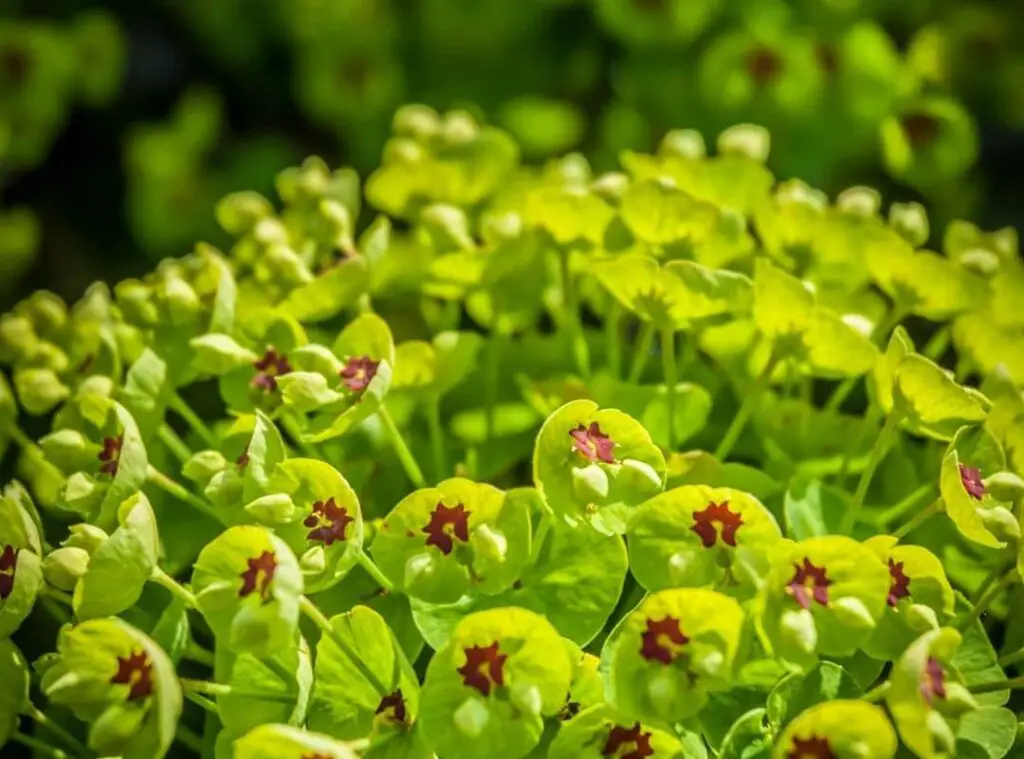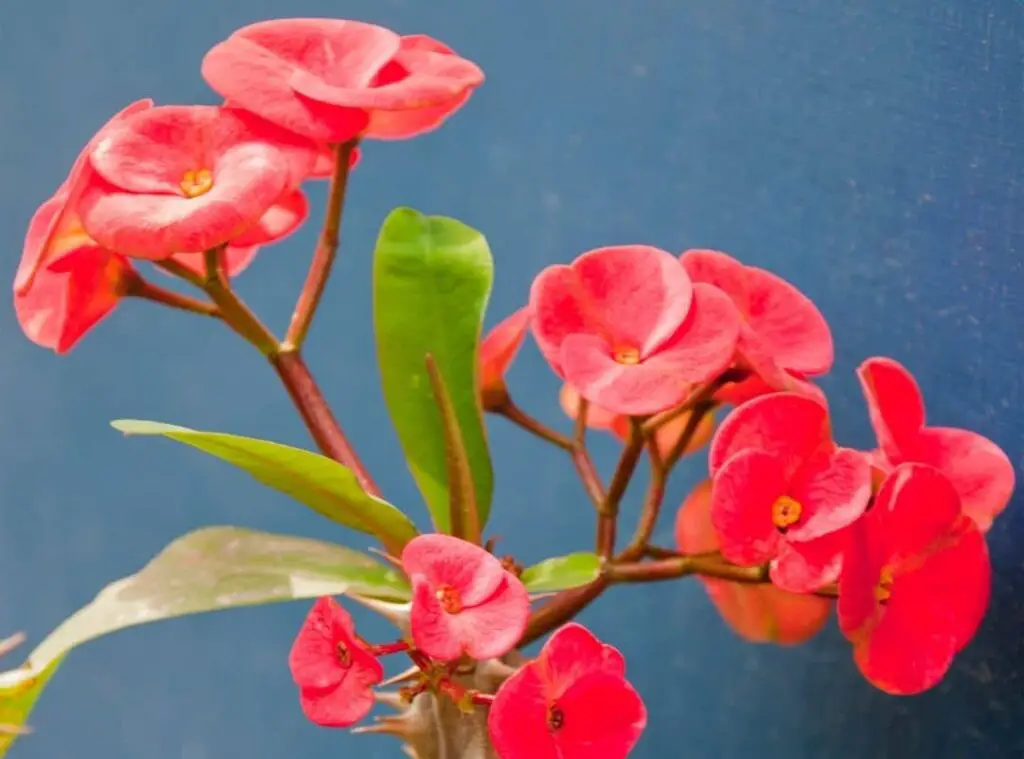Euphorbia plants belong to the family Euphorbiaceae, and we are going to cover the Euphorbia problems in this article. So, if you are planning to grow a Euphorbia plant or if you are already growing one of these, you could keep reading this article as it would be very useful.

Euphorbia Stem rot
Euphorbia stem rot could occur as a repercussion of a fungal disease. If you splash water, soil, and peat on other plants, chances are that it could even spread among those plants as well. When the fungus invades the Euphorbia plants, first the tall stems will start to rot, particularly at the limbs. You could commonly spot the stem rot among the Euphorbia plants, which are grown in the green houses.
Some people find it difficult to identify whether it is exactly the stem rot or any other diseases such as corking or sunburns.
You could mainly identify the stem rot from its brown spot; particularly if it is soft, you could assume that it is rotten. In that circumstance, you need to get rid of that part and seclude the plant part. Once the Euphorbia plants suffer from stem rot, the whole stem will perish. However, you could consider snipping off the brown area.
Further, if you think their spines are a deterrent, you could consider removing their upright spine as well. I recommend removing the stem, as it would be more productive. You may consider that a senseless act; however, if you do not do it, chances are that it could even spread faster among other parts of the plant. You could keep the healthy parts of the plants for the propagation process.
Once you segregate the healthy plant parts, you could leave them in a hot and a dry place where they can develop callous.
Further, I recommend you dip them in cinnamon, and only after that could you pot them in a grittier soil. You could sprinkle cinnamon around the cut edges. Next, you could seclude the infected cuttings. However, it is very unlikely that the fungicides would be productive here, as chances are that the entire Euphorbia plant will be infected. Having said that, you should be able to make it survive in the soil mix if you water them lightly and sprinkle cinnamon as well. Cinnamon is well known for its antifungal properties.
Euphorbia fungus
Rhizoctoria
You could spot Rhizoctoria in almost all types of soil. Rhizoctoria could invade the crown of the Euphorbia plants, particularly if they have high levels of humidity and excess moisture. This fungus type could occupy both roots as well as the stem. You could commonly spot them among the mature Euphorbia plants. Once the Euphorbia plants are under attack by these fungi, they tend to look unhealthy and limp. As they spread more, you could see how early lesions arise on the stem, particularly on the stem which interacts with the ground.
Once the attacks get more severe, those black lesions could spread right through the entire stem.
Once your Euphorbia plants go through this condition, it is important that you provide sufficient sunlight levels and temperature levels, and finally, water them appropriately too. Rhizoctoria may remain dormant in the soil until optimal conditions are met. The wording of this sentence is a little different than the one used in the video. However, you could prevent these fungal attacks from growing them in a fresh growing medium. Further, always ensure that you disinfect the tools and wash them properly once you complete gardening all the plants.
Fusarium
Euphorbia plants could get invaded with Fusarium fungus as well. It could also mainly attack the Euphorbia plants’ crown. Further you could come across many strains in Fusarium as well. They could be so irritating and annoying as they could invade the whole plant. Once they get infected with this fungus type, they could come up with wet mushy and sunken spots.
You could commonly spot these lesions at the Euphorbia plants base and those lesions would further consist with purple borders as well.
Unfortunately, it will not be possible to treat them by cutting them or pruning them. When the attack becomes more severe, those spots will come up around the Euphorbia stems. However, it is important that you act wisely to prevent these attacks, as it is always best to prevent them rather than treat them once they attack your plants.
To prevent these fungal attacks, you should be mindful to avoid watering the stems and their leaves. Further, avoid watering them on a frequent basis. Instead, water them thoroughly. Always place your fingers in the soil and check whether their soil is dry or damp.
Depending on that you need to either water them immediately or wait for some more days and water. These fungi find it very easy to spread via wounds and lesions. As such best is to get rid of the infected plants entirely and use their healthy parts for propagation.

Brown spots on euphorbia
You may come across brown spots in Euphorbias, and it could be mainly due to sunburns. When you expose the Euphorbias to full, bright sunlight all at once, the plants may get sunburned. You could commonly spot this among the plants which are grown in the green houses initially as they are more vulnerable for sunburns. Further, the plants that are grown in the green houses grow under stable conditions, and if you expose them to drastic changes in the sunlight conditions, it could result in sunburns in the plants.
To avoid this, best is to acclimate the plants for bright sunlight without exposing them at once.
Furthermore, if you grew these plants while covering them with a shade cloth, avoid exposing them to full sunlight all at once. Apart from that, if you come across any browning of the spines of the plants, it could be natural due to aging.
Euphorbia turning yellow
Your euphorbia could turn yellow due to several reasons. It could be mainly due to the mistakes you make in watering them. Literally, you should water the soil only when it is dry. You could consider watering them once a week during the summer.
If you are unsure as to whether the soil is dry or moist you could simply place your finger into the soil and check the soil condition.
In addition to the mistakes you make in watering, if you expose them to colder weather conditions, that could also result in the yellowing of the Euphorbia plants. These plants are fond of growing in warmer temperatures, so if there is any forecast of colder weather conditions, you need to take the necessary steps to protect the plants.
Euphorbia black spots
Euphorbia black spots could also be a repercussion of a fungal attack. It is critical that you address it as soon as possible, or your infected Euphorbia plant will die during the winter. If you have grown these plants in a regular potting medium, it could result in this condition. The wording of this sentence is a little different than the one used in the video.
Euphorbia turning red
Euphorbia plants turn red when you expose them to extreme summer conditions, particularly intense heat. They would literally tend to turn their stems and leaves red as a consequence of too much exposure to intense sunlight. To remedy this, you need to locate them in an area where they will be exposed to partial sunlight.
Euphorbia corking
When the Euphorbia plants are in need of their outer layer (epidermis) to be replaced, corking takes place. Initially, they would turn their older stems into brown and later the bulging of the tissues would take place. This is something which you could just ignore as it is their nature.
You do not have to bother in treating them. Ultimately, they would come up with a remedy for the older tissues. Only thing, many people find corking as something unpleasant to look at, however you need to give them some time so that they can get them out of that condition by themselves.
Wilting euphorbia
The wilting of the Euphorbia plants occurs due to a lack of water. As a result, if you notice your plant starting to wilt, look for any other signs of underwatering. If you do, you need to immediately start watering the plants. With one or two drinks of water, they could come back to normal.
Do euphorbia die in winter?
Euphorbia plants do not die in winter. In fact, winter is their dormant season, and they will be literally relaxing. When they go dormant, they will be literally saving their energy for future purposes. During this time, it is very unlikely that you will need to water them.
However, if their soil mix is bone dry, you could consider watering them lightly.
Once they complete their dormancy period, they could come out of their dormancy and start growing actively. Do not expose them to temperatures below 55 degrees Fahrenheit during the winter as it could be harmful for the plants.
Why is my Euphorbia turning white?
Powdery mildew is the culprit of turning your Euphorbias white. Powdery mildew is also yet another fungal body type which consists of a white to gray layer. Once they invade your euphorbia plants, it would take a powdery appearance just like the name these fungus bodies have inherited. It is important that you conduct the proper care treatments to avoid them attacking your beloved Euphorbia plants.

Why is my Euphorbia not flowering?
If your Euphorbias do not flower, it may be due to a lack of proper care treatments. It is crucial that your plants get sufficient sunlight levels and water amounts to flower. In addition to that, they need proper temperature levels to start flowering.
I have seen so many people tend to apply bloom booster fertilizers to stimulate the flower blossoming of the plants.
However, I do not recommend doing that. Ideally, you need to check whether your plants are showing any symptoms of underwatering or overwatering. Check to see if they were grown in a well-draining soil mix as well. More importantly, check whether your plants are receiving sufficient levels of sunlight as well.
Why is my euphorbia dropping leaves?
Under-watering is what causes these plants to drop their leaves. You might think that succulents have water stored in their bodies, so you do not need to water them. In fact, they want some amount of water for their survival. The best is to water them once a week during the summer, but do it thoroughly.
Do not start to worry if you encounter such an issue, all you need to do is supply them with some water, and they could revive with a couple of watering sessions. However, make certain that you do not over-supply them with water.
Why do crown of thorns leave curling?
Euphorbia plant crowns act as a water conservation feature of the plants. Their leaves could absorb water from them whenever they required it. As a result, if the plants run out of water, their crowns will begin to curl. This literally means, your plants are starving for more moisture. You should water them whenever you notice their soil is dry. Having said that, ensure that you do not keep it bone dry, though.
Why are the euphorbia leaves of thorns turning yellow?
If the plants are running short of necessary nutrients, Euphorbia plant leaves could turn yellow, which could ultimately result in the death of the plant. If you have grown them in an inappropriate location, it could result in your Euphorbia plant’s leaves turning yellow. To remedy this, you need to change their location and plant them in a place where they can gain sufficient sunlight levels and good aeration. Once you provide these conditions, they could revive faster.
Why are my Euphorbia spines turning brown?
If you spot your Euphorbia plant’s spines have become brown, it could be a sign of rotting, sunburns or corking. Further, if your plants have become potbound, their spines will become brown in color. Repotting would be a good way to treat this.
Special care tips
It is crucial that you follow the right growing tips when taking care of these plants. Keep in mind that you should never expose them to drastic changes in the growing conditions. You need to water them properly only when their soil is dry.
Further you have to grow them in a well-draining soil mix If there is excess moisture retained in the pot, it would lead to soggy and damp conditions in the potting medium and result in root rot etc. Apart from that, ensure that you supply them sufficient sunlight levels also. It has to be ideally 3-4 hours of direct sunlight preferably during the morning hours.
Conclusion
As long as you provide the aforesaid care tips, they will flourish and be able to overcome all these issues and diseases. I hope this article helped you learn more about Euphorbia plants and how to properly care for them.
Read Next : 7 Fungal Infection On Succulents? | How To Treat Them |
